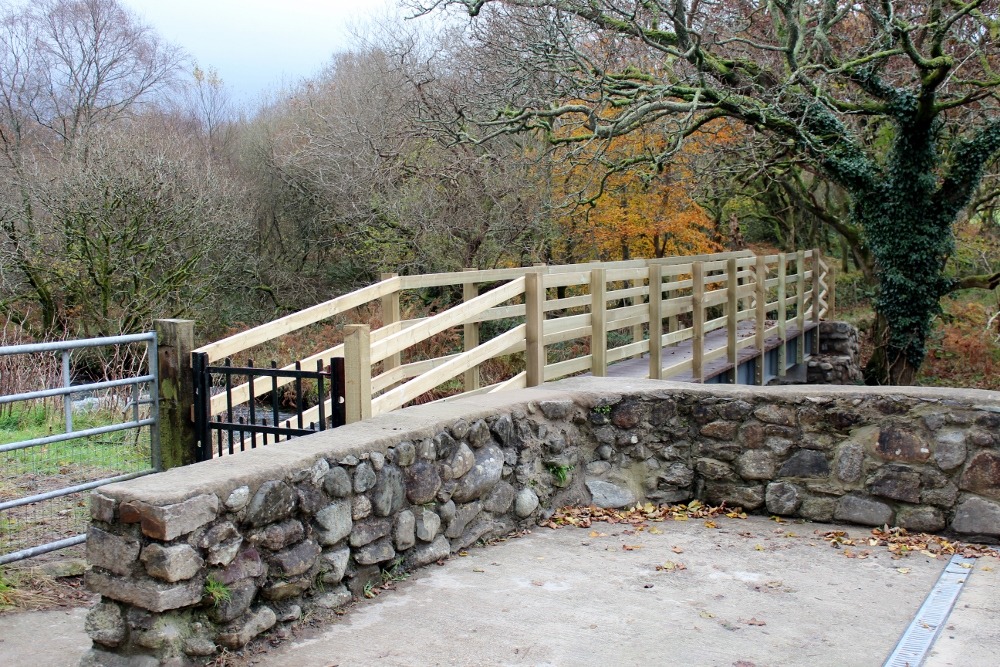The North Wales Pilgrim’s Way
Since the 7th century, pilgrims have visited four sites of particular significance in North Wales – Holywell, Gwytherin, Clynnog Fawr and Bardsey Island. The first three of these sites have links with Saint Winifred and Saint Beuno. The North Wales Pilgrim’s Way connects many locations which are associated with saints. The Woollen Mill is situated on Clynnog Road and is a just short distance from Clynnog Fawr. The North Wales Pilgrims Way passes directly in front of the mill and we often see pilgrims walking past. The trail is supposed to continue across the footbridge adjacent to The Woollen Mill and over the river but the somewhat decrepit bridge has been closed by Gwynedd Council as it is in such a poor state of repair. Most pilgrims who walk the trail continue to cross the bridge anyway!
The North Wales Pilgrims Way is a long distance walking route beginning near Holywell and ending at Bardsey Island. At 133.9 miles long, it is best tackled over several days and is a contemporary interpretation of the route pilgrims would have taken across North Wales in medieval times. The development of the trail began in 2011 and the route, which links ancient churches dedicated to the saints of the 6th century, was officially opened in 2014.
Walking the North Wales Pilgrim’s Way gives you the opportunity to visit holy sites and to escape the stresses of everyday life while admiring the incredible wildflowers and wildlife along the trail. In addition to visiting the churches on the route, you can take time out to hike up Snowdon or to experience the many other attractions in the region.
Saint Winifred and Saint Beuno
Saint Winifred (or Winefride) (Welsh: Gwenffrewi) was a 7th-century Christian woman and virgin martyr . Her story is the stuff of legend. According to that legend, she was the daughter of the Welsh nobleman, Tyfid ap Eiludd. Her mother was Wenlo, a sister of Saint Beuno. When Winifred decided she wanted to become a nun, her suitor Caradog was so angry, he decapitated her! A spring with healing powers appeared at the spot where her head fell. Winifred’s head was later reunited with her body by Saint Beuno and she was restored to life. Beuno found the murderer and called on heavenly powers to chastise him. Caradog dropped dead and then the ground opened up and swallowed him. Before leaving for Caernarfon, Saint Beuno said, “whosoever on that spot should thrice ask for a benefit from God in the name of St. Winefride would obtain the grace he asked if it was for the good of his soul.” The healing spring is now the shrine known as St. Winifrede’s Well in Holywell. It is sometimes referred to as the Lourdes of Wales.
Saint Beuno is thought to have been born at Berriew in Powys. He is believed to have been the grandson of a prince decsended from Vortigen, King of Britain. He was educated and ordained at a monastery in Bangor after which he became a missionary. Beuno was later deceived over a portion pf land by Cadwallon, King of Gywnedd. Cadwallon’s cousin then gifted Beuno his land at Clynnog Fawr where Beuno established his own monastery. The saint has been credited with raising seven people from the dead including his niece Winifred.
Walking the North Wales Pilgrim’s Way
The route can be walked in stages which are easy to cope with and which enable you to visit local attractions along the way in addition to the sacred sites. Here’s the suggested itinerary, but you could combine stages if you prefer longer walks on each day.
Basingwerk Abbey to Pantasaph 3 miles
Pantasaph to Maen Achwyfan 3.3 miles
Maen Achwyfan to Llanasa 2.7 miles
Llanasa to Trelawnyd 2.4 miles
Trelawnyd to Tremeirchion 6 miles
Tremeirchion to St Asaph 3.5 miles
St Asaph to Llannefydd 6.3 miles
Llannefydd to Llansannan 4.5 miles
Llansannan to Gwytherin 7.0 miles
Gwytherin to Pandy Tudur 3.4 miles
Pandy Tudur to Llangernyw 2.5 miles
Llangernyw to Eglwysbach 7.5 miles
Eglwysbach to Rowen 3.5 miles
Rowen to Penmaenmawr (Stone Circles) 4.4 miles
Penmaenmawr (Stone Circles) to Abergwyngregin 6.6 miles
Abergwyngregin to Bangor:- 12.33m
Bangor to Llanberis:- 10.6m
Llanberis to Waunfawr 4.5 miles
Waunfawr to Penygroes 7.1 miles
Penygroes to Clynnog Fawr 6.3 miles
Clynnog Fawr to Trefor 4 miles
Trefor to Nefyn 6.3 miles
Nefyn to Towyn (Tudweiliog) 6.8 miles
Towyn (Tudweiliog) to Porth Oer (Whistling Sands) 8 miles
Porth Oer to Aberdaron 3.3 miles
Bardsey Island
Bardsey Island marks the end of the North Wales Pilgrim’s way and is known as the Island of 20,000 Saints. Situated 1.9 miles off the Llŷn Peninsula, it is just 0.6 miles wide and 1 mile long. The Island has been a significant religious site since Saint Cadfan built a monastery there in he 6th century. Bardsey Island has attracted many pilgrims since medieval times despite Henry VIII having dissolved and demolished the monastery in 1537. Believed by many to be the burial place of King Arthur, the tiny island is a place of both fascination and spirituality which is renowned for its incredible wildlife and stunning scenery.
Inhabited since Neolithic times, Bardsey Island became a refuge for the persecuted. It was a burial place for those considered the bravest or best in Wales and some considered it to be the gateway to heaven. So important was the Island, that eventually three pilgrimages to Bardsey were considered to be the equal of one to Rome. A Celtic Cross has been positioned in the ruins of the abbey to commemorate the 20,000 Saints believed to be buried on the island.
The Footbridge
The dilapidated footbridge over the Llyfni had been closed for several years, forcing pilgrims to take an alternative route. Happily, the bridge was finally replaced November 2019. It is now possible to walk the North Wales Pilgrim’s Way without taking a significant diversion. We spent two years trying to get the bridge replaced. After all attempts to persuade the council to deal with the issue failed, we were forced to go to the press. The Daily Post were kind enough to feature the story of the bridge and Gwynedd Council reacted quickly after the piece was published.
The new bridge is a considerable improvement on the old one and is being used every day by pilgrims, hikers and local people. We are always glad to see walkers crossing the river safely rather than having to brave the old crossing or retrace their steps.



